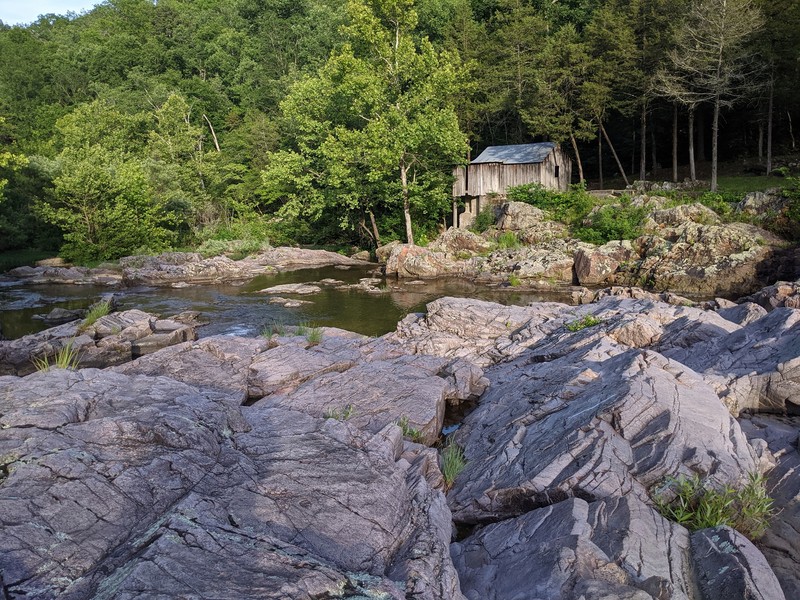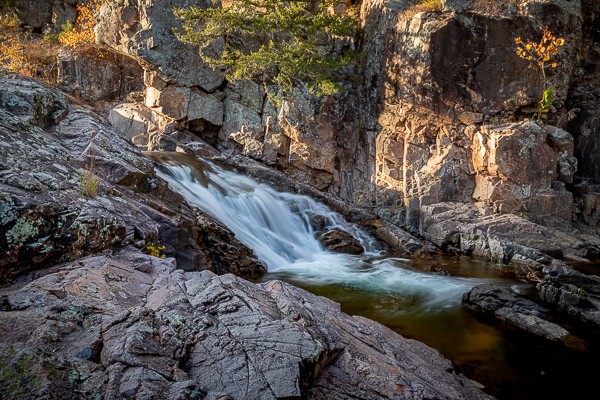Klepzig Mill and Farm
Introduction
Text-to-speech Audio
The Klepzig Mill on the Rocky Creek Farm is one of the few surviving mills located in the rugged Southern Courtois Hills region; the Klepzig is the only one of “sawmill” construction. Developed over a period from 1912 to 1934, the historic mill's development occurred during a time many historians describe as the second of three instrumental periods of growth for the Southeast Missouri Ozarks, referred to as the "New South Ozarks." Walter Klepzig embraced the progressive business philosophies connected to the New South Ozarks model, which allowed him and his family to achieve a modest form of prosperity.
Images
Klepzig Mill

Rocky Creek Falls

Backstory and Context
Text-to-speech Audio
The Klepzig Mill and Farm arose on land originally provided to David Reed in 1857 as part of a federal land grant; he received seventy-eight acres. Two of the farm’s early owners included G.W. McCaskill and Joshua Sholar, two local leaders in the New South Ozarks era connected to the area's timber boom and the arrival of the railroad to the region. McCaskill was one of three native Shannon County brothers who built and operated multiple grist and sawmills, and they operated several large-scale commercial operations in the area. McCaskill purchased this farm in 1890 and then sold it eight months later to Joshua Sholar who kept it until 1898. Sholar increased the size of the property to 121 acres. Sholar also worked as an editor of the Current Wave in Shannon County where he wrote pieces deploring the reluctance of Shannon County farmers to join the new, i.e. the New South, business order. He advocated increased crop production and the conversion of excess grain to flour and meal for market sales.
When Walter Klepzig acquired the farm in 1912, the property remained largely uncultivated and much of the forests had not been cleared. Klepzig acquired on the property a log cabin and the remains of a flood-destroyed mill, likely damaged during the robust "Winona flood" in 1895. Despite the flood-ravaged mill, the fast-flowing stream branches made the property attractive to prospective millers, including Klepzig. He made improvements to the property such as repairing roads to and from the farm and clearing additional land. Still, only about forty-five acres proved suitable for cultivation. He built structures used for farming and replaced the log cabin with a house more commonly found during the 1910s. And, Klepzig reconstructed the mill.
Klepzig, son of “Prussian German” Charles Klepzig, another Shannon County entrepreneur, embraced the New South business philosophies championed by Sholar. Klepzig built barbed and woven wire fences, purchased refined breeds of milk cows, and took advantage of outside marketing opportunities such as shipping cream to Beatrice, Nebraska, for processing. The Klepzig Mill sat at an ideal spot along a narrow section of Rocky Creek, where the creek’s waters traverse a series of narrow gorges, regionally referred to as “shut-ins.” The narrow gorges proved easy to dam, and the sharp drop in elevation supplied the necessary force to the water’s flow, and the water wheel it powered. During the twenty years Klepzig owned the mill, he upgraded both the hydraulic system and the mill, changes compatible with his progressive farming methods. The improvements included updating the mill stones and replacing the wheel with a more modern turbine.
The mill provided additional income to an otherwise self-sufficient farmer. Klepzig operated the three-bushel-an-hour mill three days each week, with Saturday the busiest day, often working from sunrise to sunset. His customers included farmers from a radius of more than ten miles, a typical situation in the Southern Courtois Hills. Indeed, the Klepzig farm and mill typified most Ozark farm and mill sites. The region's farmers conducted trading only four times a year in the closest town, Winona. Self-sufficiency remained a strong characteristic of Ozark farmers and mill owners; Klepzig maintained his own Blacksmith shop and he proved to be a skilled carpenter. He even managed to gain extra horsepower for his turbine by using an axle of a Ford truck. Like their neighbors, the Klepzigs’ diet consisted primarily of cornbread and biscuits. The region's mill seats sat mainly isolated from each other, up to fifteen miles apart, separated by the rugged terrain, which also slowed cross-country traveling. Walter’s son noted that his journey to his one-room school was “bad on sore toes.” Still, the Klepzig business philosophy allowed the family to enjoy modest prosperity, which allowed them to afford such luxuries as owning the area's first radio.
Walter moved away from the Rocky Creek Farm and the now-historic mill in 1925, leaving the property in his sons' control until 1931. A.C. Brandt, a St. Louis electrical equipment supplier, purchased the property from the Klepzig family. The improvements Brandt made effectively spelled the end of the New South Ozarks period, the second of three significant growth periods in the Southeast Missouri Ozarks. While the Brandts upgraded the mill, they mainly came to retire. The mill's effectiveness waned by the 1930s anyway, as the nation's consumers turned to store-bought meal products and flour. So, rather than try to profit from the mill, they arrived in the region with a plethora of hunters, anglers, and recreationists, ostensibly ushering in the third period of growth known as the “Cosmopolitan Ozarks”
Cite This Entry
Powers, Mathew. "Klepzig Mill and Farm." Clio: Your Guide to History. August 10, 2022. Accessed March 29, 2025. https://theclio.com/entry/155705
Sources
Corless, James P. "Registration Form: Klepzig, Walter, Mill and Farm." National Register of Historic Places. mostateparks.com. 1990. https://mostateparks.com/sites/mostateparks/files/Klepzig%2C%20Walter%2C%20Mill%20and%20Farm.pdf.
Disch, Greg. "Klepzig Mill." Greg Disch Photography Workshops. gregdish.com. Accessed August 7, 2022. https://gregdisch.com/2019/02/05/klepzig-mill/.
"Historic Mills: Klepzig Mill." West Plains Missouri. Accessed August 9, 2022. https://explorewestplains.com/klepzig-mill/.
"Klepzig Mill." Natioal Park Service. nps.gov. December 18, 2017. https://www.nps.gov/ozar/learn/historyculture/klepzig-mill.htm.
"Klepzig Mill and Farm: Cultural Landscapes Inventory." National Park Service. npshistory.com. Accessed August 8, 2022. http://npshistory.com/publications/ozar/cli-klepzig-mill.pdf.
Ozark National Scenic Riverways: https://www.facebook.com/photo/?fbid=4350263121705173&set=a.151842911547236
Greg Disch: https://gregdisch.com/2019/02/05/klepzig-mill/

